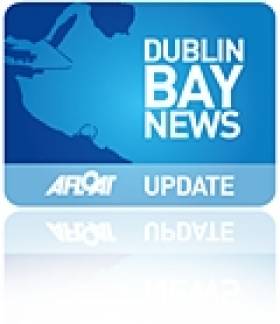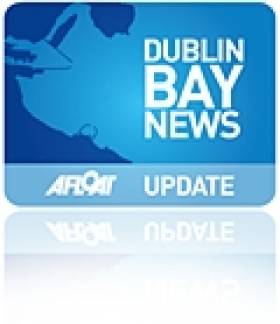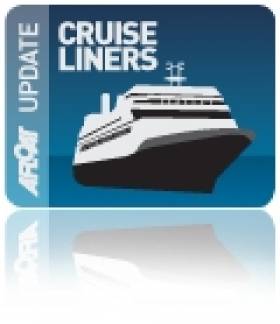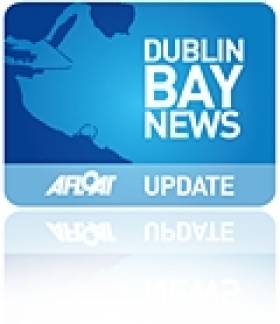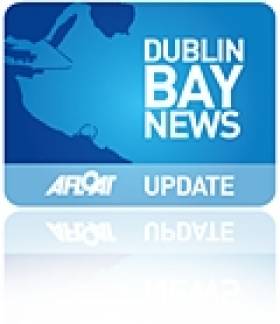Displaying items by tag: Dublin Bay News
#DMYC – A new annual award to recognise the outstanding contribution by junior sailors was launched yesterday by Sir Bob Geldof at the Dun Laoghaire Motor Yacht Club (DYMC). The DMYC Bob Geldof Spirit of Sailing Memorial Award is named in honour of the late Bob Geldof, father of Sir Bob Geldof, who was a long standing member of the DMYC. The first recipient of the Award was Conor Ryan (age 17) from Dalkey . He was presented with the Award at a ceremony on Saturday by Sir Bob Geldof in recognition of excellence in demanding sailing and racing achievements. In particular Conor's swift transfer from junior sailing rank to full DBSC (Dublin Bay Sailing Club) racing membership was commended.
According to Liam Owens, Commodore, DMYC , the Memorial award comes at a fitting time when the Club has a number of initiatives to highlight the many benefits of sailing to young people.
"The late Bob Geldof was an avid and accomplished sailor. He was a founding member of our Club back in 1965 and always encouraged and nurtured young people who wanted to gain experience and enjoy our sport. He was a much loved member of the DMYC from its earliest years until his death. The Geldof family mindful of his close connections with our Club has donated this new annual award to commemorate his memory and to inspire a new generation of junior sailors at the DMYC."
"This award is particularly apt, as we are actively seeking to promote the fun, energetic and thrill of sailing to young people. We want to encourage more people to embrace the sport and get out on the water and to help people in these recessionary times we are offering free membership to 16-19 year olds. New members do not need to have their own boat and existing members are always delighted to welcome newcomers to crew on their boats".
The DMYC has always maintained a key priority on offering 'affordable sailing'. It provides relevant support and back-up for a diverse range of marine activities such as angling, diving as well as for the core activity of the club – Sailing. The DMYC contributes to Dublin Bay racing through its organisation of its September Series and the Winter Frostbites for the more experienced sailors. The Club organises Junior Sail Training Programmes and is strongly involved in organising cruises-in-company for more mature sailors in Summertime to selected ports and locations up and down the Irish Sea and cross-channel.
"We like to think of our club as a home from home for members. Throughout the Winter season we host a strong and vibrant series of guest lectures on areas of cultural and nautical interest. These are highly popular social suppers where both Members, their friends as well as non-members can enjoy. It is fitting today that we announce our memorial award to one of those members, the late Bob Geldof who certainly viewed our Club as a home from home," concludes Commodore Owens.
#DUBLIN BAY RIGS – The jack-up rig Excalibur returned to Dublin Bay yesterday, having previously carried out preliminary bore test-site drilling work last year for a new sewage pipeline. As reported last year the sight of several floating structures gave the distinct impression that oil had been struck and again the presence of the rig's purpose is further from true with no such oil-exploratory activity taking place, writes Jehan Ashmore.
The rig is in Dublin Bay for several weeks and is to carry out further site investigation to ascertain the most suitable route of a new under the seabed laid sewage pipeline for the €220m Dublin Bay Project, where the principle contractor for the project is Fugro Seacore.
According to Dublin City Council, the impact of the new outfall location on the outer fringe of Dublin Bay will be 'localised'. They also claim that the project is to further improve water quality in Dublin Bay. Under the terms of the waste-water discharge license issued by the EPA, the pipeline must be completed by 2015.
Currently wastewater is discharged at Ringsend where the the Wastewater Treatment Plant in processes a 1.9m population equivalent. The new outfall pipe and associated works is to address increased demand and will be able to increase the capacity to a 2.1m population equivalent.
The Excalibur was towed from Holyhead by the tug MTS Valiant, to a position close to the Dublin Bay Buoy, the primary navigational mark which acts a 'round-about' for shipping using Dublin Port. The Excalibur is essentially a large barge with several sea-legs than can be lowered onto the seabed, where upon the barge itself rests while hoisted above the waterline.
On board is a crane, porta-cabin like facilities for crew, a service workboat and a lifeboat. During the construction process there will be a guard-boat which will monitor other shipping activity, as a safety precaution. One of the first vessels to pass Excalibur was the 113,000 tonnes giant cruiseship Carribean Princess which edged cautiously by while outward bound yesterday for Belfast.
The treatment plant in Ringsend was built in 2003, in which the superior plant replaced an older facility closer to the Poolbeg Harbour at the foot of the now disused ESB Power Station. Up until then, two-thirds of the greater Dublin region was treated but only at this primary level where 60% of waster-water went straight through the facility into the Liffey, the balance of 40% had polluntants removed to form sludge which was disposed out at sea.
This uneviable of tasks was performed by the wastewater disposal vessel Sir Joseph Bazalgette (1963/2,258grt) which saw some 40m gallons discharged into the spoiling grounds off Dublin Bay and Kish Lighthouse.
The former London County Council commissioned vessel worked on the Thames until sold to Dublin Corporation. On occasions she would head back to port via a transit of Dalkey Sound.
Despite her sale to overseas buyers in 1999, she remains one of the largest vessel's in modern times to make a passage of the sound that marks the southern approaches to Dublin Bay.
#DUBLIN BAY NEWS - As Dubliners enjoyed the sunshine by the seaside yesterday, things got a little too heated at the Forty Foot in Sandycove when a fracas broke out between two groups of young men at the popular bathing spot.
According to RTÉ News, bottles were broken and a number of people were injured in the row, which occurred after the two groups – from the Crumlin and East Wall areas – had been drinking for some hours.
Three were arrested by Gardaí at the scene and released this morning, while four people were treated for minor stab wounds after the incident. It is thought that some 20 people were involved in the altercation.
Cruise Call Opens New Opportunities for Dun Laoghaire Harbour
#CRUISE CALLS - The docking of the Quest in Dun Laoghaire Harbour this morning marks the first phase of cruise calls this summer as part of a new development to attract cruiseships, writes Jehan Ashmore.
The opening of the cruise sector business which formed part of the Dun Laoghaire Harbour Company's Masterplan is seen as a significant boost to the local economy considering the declining operations of the HSS fast-ferry service in recent years.
The Quest which is operated by Noble Caledonia is on a 9-night 'Garden' Cruise of the UK and Ireland, where prices started from £3,295. She berthed at the Carlisle Pier where for many generations passengers boarded the mail-boats followed by the conventional ferry to Holyhead which last left the route in 1996.
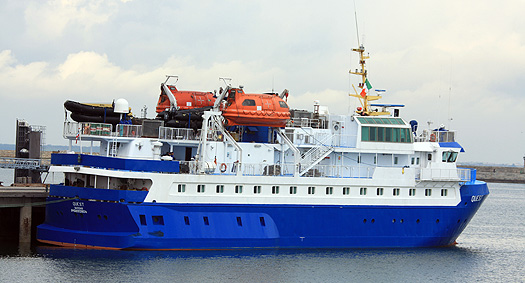
Quest along side in Dun Laoghaire. She carries 50 passengers
At just under 50m long the Quest carries only 50 passengers though this number is set to increase when a further four cruise calls are scheduled this season with larger vessels capable of carrying around 500 passengers.
#CRUISELINERS – The Quest (1992/1,180grt) an ice-strengthened expedition cruiseship, will have the distinction of being the first cruise caller to Dun Laoghaire Harbour in many years. The cruise call next week (24th April) will mark a new era in attracting the cruise sector as part of the harbour's masterplan launched last year, writes Jehan Ashmore.
The Quest will have a German clientele of around 50 passengers, though other larger capacity vessels are scheduled for the summer in this first phase of cruise callers. The cruise sector season is seen to be a significant economic boost to the local economy considering the reduced ferry side of the harbour business in recent years.
Passengers on the Noble Caledonia operated vessel are to take a 9-night 'Garden' Cruise with prices starting from £3,295. She is to set sail from Oban Scotland, then to Ireland, Wales, Cornwall, the Isles of Scilly and Channel Islands.
On her Dun Laoghaire call passengers will head for Powerscourt and nearby Mount Usher gardens in Co. Wicklow. On the second Irish port of call to Waterford as previously reported, they will visit the privately owned Mount Congreve Gardens on the banks of the River Suir.
Notably scheduled in for next year's season is the 'flagship' of the Cunard Line fleet, the 2,620 passenger liner Queen Mary 2, all of 151,400 gross tonnes. She is to make an anchorage call in May 2013, according to Captain Frank Allan, Dun Laoghaire Harbourmaster.
As part of the programme to attract and develop Dun Laoghaire as a cruise call port of call, a new tender docking facility was recently completed. The facility is designed to cater for large cruiseships using the harbour as it will cater for easier access by boats tendering passengers to vessels such as Queen Mary 2 during anchorage calls out in Dublin Bay.
The new tender facility will also benefit the public as the facility can be used for training purposes and for the operation of boat tours around Dublin Bay and trips out to Dalkey Island.
- Dun Laoghaire Harbour
- Cruise Liners
- Irish cruise calls
- Noble Caledonia
- MVQuest
- Cunard Line
- Queen Mary 2
- QM2
- Dun Laoghaire Harbour Company
- Dublin Bay
- Dublin Bay anchorage cruise calls
- Dalkey Island
- Powerscourt Gardens
- Mount Congreve Gardens Waterford
- River Suir
- Dun Laoghaire Harbour Masterplan
- Dublin Bay News
Easter Sunday Marks Rebirth of Mariners Maritime Museum
#MARTIME MUSEUM AT EASTER - Earlier this week Dun Laoghaire's maritime museum re-opened its doors to the public after a €4m renovation project was carried out on the apt venue of the former Mariners Church, which incidentally closed on this Easter Day forty years ago, writes Jehan Ashmore.
With a new lease of life the extensively renovated and upgraded museum can look forward to a future. Visitors enter the museum at a new entrance, where in the reception foyer there is a souvenir shop, beyond that in the main body or nave are exhibits displayed, each telling a story and for children there is a Knott Station. To view the initial exhibits on display, click HERE.
In addition there is new facility in the form of a café, which was much needed and where two new stained -glass windows by Peadar Lamb feature, they were sponsored by the Dun Laoghaire Harbour Company. As for the original stained-class windows they were restored to their full glory.
The renovation began in 2006 and was funded by the Government which led to a three-phrased project that involved work carried out from the re-roofing right down to the floorboards. Walls were re-plastered, electric systems modernised and wheel chair-lift and ramps installed.
Work also took place to clean the exterior of the stone-cut granite building hewn from Dalkey Quarry and which led to the consecration of the Kingstown Episcopalian Mariners Church in 1843.
After many generations of mariners and their families, parish numbers dwindled and its use as place worship ended on Easter Sunday 1972. The Maritime Institute of Ireland which runs the museum relocated two years later having had a smaller museum sited along the town's harbour waterfront.
For the next three decades the museum which has attracted locals and visitors from home and overseas, eventually had to close due to deteriorating conditions of an aging building.
Now that the museum is up and running, the M.I.I. which is staffed by volunteers has in recent years also had the support of a FAS scheme of workers, which according to the institute have been invaluable.
The museum is open 11am to 5pm Tuesday to Sunday and every Bank Holiday, for further information visit: www.mariner.ie
New Lease of Life for Reopened Maritime Museum
#MARITIME MUSEUM REOPENING – It is good to report positive news, particularly the much awaited reopening of the Maritime Institute of Ireland's maritime museum in Dun Laoghaire, which is to take place today, writes Jehan Ashmore.
Since 2006, the museum secured vital Government grants to undertake repair, renovation and improvement works of the former Church of Ireland church built in 1837 which could accommodate up to 1,400 people. Due to dwindling parish numbers the church closed on Easter Sunday 1972 and two years later the museum moved in.
Over the next three decades visitors enjoyed the unique and apt setting of the former Mariners Church. However as the years rolled the structure of the building was in need of urgent attention which led to the closure in 2004.
The extensive work has included the replacement of the roof, treatment of dry rot, repointing and cleaning of the stonework, replaced plasterwork, repair of the stained glass windows, installation of new lighting and heating systems and wheelchair accessibility provided.
Initially the museum will only use the ground floor, having said that a new layout is presented with several 'stories' centred around these exhibits, to read more about the exhibits click HERE.
In addition children will be entertained by a Knot Station and there is to be a souvenir shop and coffee dock. Opening hours are 11am to 5pm Tuesday to Sunday, including Bank Holidays, for further information visit: www.mariner.ie
The Maritime Institute of Ireland celebrated its 70th anniversary last year, and was established primarily to highlight the importance of an Irish mercantile fleet, the role of ports and shipping, fishing and to recognise and foster our maritime heritage.
Members can join the Institute with the benefits of accessing the museum (covering admission) runs a lecture programme, issue newsletters, host and support commemorations and conducts research. As a voluntary organisation they also welcome new recruits.
The instiute's patron is President Michael D. Higgins who is to officially reopen the museum in early June.
Dun Laoghaire's Maritime Museum to Re-Open
#MARITIME MUSEUM-The much awaited re-opening of the Maritime Museum in Dun Laoghaire, Co. Dublin is to take place in April, writes Jehan Ashmore.
The museum which is near to Dun Laoghaire Harbour's East Pier, is to reopen on Tuesday 3rd April between 11am t- 5pm. Throughout the season, these same visiting hours apply Tuesdays to Sundays, though the museum will be closed on Mondays.
To read more about the initial exhibits on display (click HERE) in the apt surroundings of the former Mariners Church, where major and essentail renovation work took place over several years. The museum which is run by the Maritime Institute of Ireland (M.I.I.) celebrated its 70th anniversary last year and with the reopening they can now look forward to a new and exciting era.
Located on High Terrace, a Cul-de-Sac that links the town's main shopping thoroughfare on Georges Street Upper to The Metals, the pedestrian walkway –is only minutes away from the Dun Laoghaire DART station.
Car parking is limited in the immediate vicinity though there are car-parking facilities nearby in the Pavilion which is accessed along the harbour waterfront (Queens Road) and the Dun Laoghaire Shopping Centre approached from Marine Road.
In addition to visiting the museum the M.I.I. also welcome members and volunteers to assist in hosting lectures, producing newsletters, journals, a library, hosting and supporting commemorations in addition to conducting research and highlighting Irelands maritime heritage. For further information click HERE.
- Dublin Bay News
- Dun Laoghaire Harbour News
- Dun Loaghaire Harbour
- Mariners Church Dun Loaghaire
- Maritime Institute of Ireland (M.I.I.)
- M.I.I.
- Dun Laoghaire Shopping Centre
- Pavillon Car Parking
- The Metals
- Dun Laoghaire DART station
- Dun Laoghaire Harbour''s East Pier
- East Pier, Dun Laoghaire
- Irish maritime heritage
- Irish maritime museums
Minister Rejects Public Inquiry into Dublin Bay Oil Drilling
#DALKEY ISLAND PROSPECT – Environment Minister Phil Hogan has rejected a call by Tánaiste Eamon Gilmore and others for a public inquiry into Providence Resources foreshore licence application to survey and drill for oil and gas in Dublin Bay, the Irish Times reports.
Mr Hogan has said that as the application by Providence Resources for survey and drilling work 6kms off Dalkey Island was the subject of public consultation, he did not consider a public inquiry "necessary".
Tánaiste and Labour Dún Laoghaire TD Eamon Gilmore said earlier yesterday that Mr Hogan should exercise his right to hold an oral hearing under the foreshore legislation. Last month, the Green Party and a number of residents in the Dalkey area also called for an inquiry.
Speaking in Galway yesterday, Mr Gilmore acknowledged that a "couple of wells" had been drilled in Dublin Bay previously, but there were a "lot of issues" relating to the current application.
To read more about this story click HERE
Campaign to Stop Planned Oil Drill off Dalkey Island
#DALKEY ISLAND PROSPECT - An online petition organised by Protect Our Coast in protest over plans by Providence Resources to start exploratory drilling for oil and gas off Dalkey Island, in south Co. Dublin, has reached over 2,000 signatures to date, including support from overseas.
Providence Resources are seeking permission from the Department of Environment for a foreshore licence to carry out site investigation and drill testing in waters depths of 20-30m in the Kish Bank Basin, at the Dalkey Island 'Prospect'.
They propose drilling one exploratory well some 6kms offshore, though the exact location chosen for the well site is subject to results of seismic surveys. This particularly area lies closer to the coastline, as it is on the more westerly fringes of the exploratory block (33-21) zone.
The campaigners object to the proximity of the well site off Dalkey Island which is designated a Special Protection Area (SPA). The island is home to a resident herd of goats, is rich in birdlife, seals and cetaceans, notably bottlenose dolphins in neighbouring Killiney Bay, which have drawn recent media attention and aided the objectives of the campaign, see www.protectourcoast.net
In addition they oppose the drilling location given its closeness to a large urban population and the risk of an oil-spill and consequent effects to humans and the environment throughout Dublin Bay.
If granted, exploratory work is due to start this year, with Providence claiming the entire process would take up to six months, between survey and drilling operations. During part of that timeframe, up to two seismic vessels will be employed, prior to deploying a 'jack-up' rig to the well site.
Should the oil be commercially viable, the benefits of becoming self-sufficient and security of supply would be of significant economic benefit to Ireland. To date 100% of the country's oil and 95% of its gas is currently imported, and yet most of Ireland's natural resources are unexplored, according to Providence Resources.
Exploration is an expensive exercise and has no guarantee of discovery while the timeframe from discovery to production can typically take five to seven years.
"Yet," say Providence Resources, "the implications of discovering and utilising such a natural resource, and potentially becoming self-sufficient in energy terms, would be of significant economic benefit for Ireland Inc. in terms of taxation, employment, security of supply and skills development."
To read more information about Dalkey Island Prospect from Providence Resources, with maps, montages (including views from White Rock Beach) newsletters and video presentation visit www.providenceresources.com/dalkeyisland.aspx
As previously reported on Afloat.ie, the application for the foreshore license is currently on view in Dalkey and Dun Laoghaire Garda stations. The application contains maps, plans, and drawings which can be inspected, noting the public consultation process ends on Thursday 2nd February 2012.
In addition for information from the Department of Environment's website, click HERE. Those wishing to make an objection or representation of the sought license should make submissions to the Foreshore Unit of the department on close of business (also) on Thursday 2nd February 2012.
.
- Dalkey Island Prospect
- Dublin Bay News
- Providence Resources
- Protect Our Coast
- Dublin Bay Oil drilling
- Killiney Bay
- Dalkey Island
- Dalkey Island Goats
- Dalkey Dolphins
- Department of the Environment
- Foreshore License
- White Rock Beach
- Killiney Beach
- Kish Bank Basin
- Special Protection Area
- SPA
- JackUp rig
- seismic survey
- Irish economy
- Online petition
- Well Site
- Exploratory Well Kish Bank Basin
- Cetaceans
- bottlenose dolphins



























